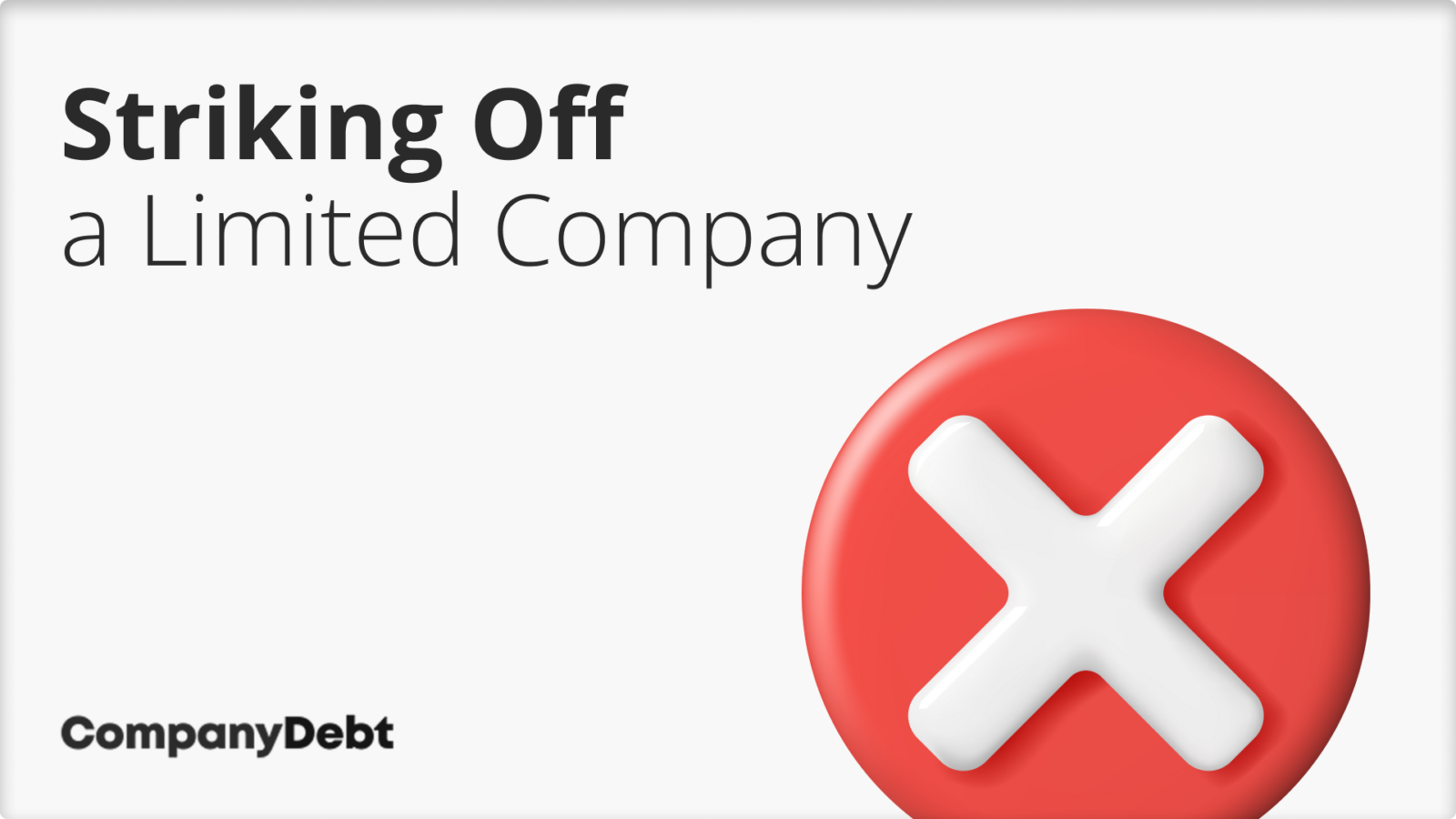Strike off a Company from the Register
- What Does ‘Striking Off a Company’ Mean in the UK?
- Why Would a Company be Struck off?
- What do I Have to Do Before Striking off my Limited Company?
- What’s the Strike Off Process?
- How Long Does Striking off a Company Take
- How Much Does it Cost to Strike off a Company?
- Potential Drawbacks of Striking Off a Limited Company
- Can you Strike off an Insolvent Company?
- What is an Objection to a Company Strike Off?
- Can a Struck off Company be Reinstated?
- FAQs on Company Strike Off
What Does ‘Striking Off a Company’ Mean in the UK?
A company strike-off, sometimes referred to as dissolving a company, is the process of removing a limited company from the Companies House register[1]Trusted Source – GOV.UK – Strike off your limited company from the Companies Register.
Once the company name is removed from the register (using Form DS01), it no longer exists.
There are two types of Company Strike Off:
- A Voluntary Strike Off is where the directors choose to dissolve the company. A company can only be lawfully dissolved where it is solvent and has paid all debts.
- A Compulsory Strike Off is when another party – usually Companies House – petitions to have the limited company struck off. Note that only solvent companies can be dissolved; if there are any outstanding debts, they must be paid in full before the company is closed.
Dissolving a company can be a simple, cost-effective way to close down a solvent company with no assets. In all cases, it is advertised in The Gazette, which is the official journal of public record.
It’s never appropriate for a company with debts, however, as I’ll explain below.

Why Would a Company be Struck off?
A company might be struck off for various reasons, including:
- Directors’ Retirement: If no successors are available, directors might choose to close a solvent company that has not traded or changed its structure in recent months.
- Pursuing New Opportunities: Directors wanting to focus on new ventures may opt to strike off an existing business, especially if selling it isn’t feasible.
- Corporate Restructuring: After reorganising a group of companies, a non-essential ‘shell’ company with its assets reallocated may be cost-effectively dissolved.
- Unprofitability: Companies that are not financially viable or cannot scale effectively might be struck off to cut losses.
- Internal Conflicts: Persistent disagreements among directors and shareholders can lead to dissolving the company if resolutions are unattainable.
What do I Have to Do Before Striking off my Limited Company?
- Complete all outstanding work and collect any revenue you’re owed.
- Sell company assets and inventory and distribute the proceeds among the shareholders.
- Prepare final accounts and a company tax return, and submit them to HMRC and Companies House.
- Pay any outstanding tax liabilities to HMRC.
- Ask HMRC to close down the company’s payroll scheme.
- Deregister for VAT, if applicable.
- Settle the company’s outstanding debts.
- Close any company bank accounts.
- Transfer website domain names and terminate any remaining monthly services, such as utilities.
What’s the Strike Off Process?
1. Secure Agreement from All Parties
Before embarking on the company dissolution process, obtain the written consent of both directors and shareholders. Directors must also sign a Declaration of Solvency.
2. Collect Debts and Settle Obligations
Make every effort to recover outstanding payments before announcing the company’s closure. Settle outstanding PAYE, NI, Corporation Tax, and other tax liabilities.
3. Complete Pending Work and Contracts
Ensure all ongoing work is finalised, and all outstanding debts are paid. Fulfill existing customer contracts or negotiate early terminations.
4. Liquidate Assets and Inventory
Dispose of any remaining stock or company assets to generate funds for debt repayment, tax obligations, employee compensation, and loan settlements. Distribute any remaining funds to the company’s owners.
5. Notify HMRC and Deregister for VAT
Inform HMRC of the company’s impending closure by submitting final accounts, a company tax return, and letters from shareholders and directors confirming the situation. A single letter suffices if directors and shareholders are the same.
Deregister for VAT if applicable. Pay final wages and salaries to employees before requesting HMRC to close the company’s payroll scheme.
6. Submit Form DS01 and Declaration of Solvency
Within 15 days of passing the resolution, send the resolution and Declaration of Solvency to Companies House. Complete and submit Form DS01 along with a £10 filing fee. A majority of directors must sign the form if there are three or more.
Upon receiving Form DS01, Companies House will verify the information and provide confirmation via mail. The strike-off application becomes an Active Proposal to Strike Off at this point.
7. Publish Notice in Gazette and Notify Interested Parties
A notice will be published in the relevant Gazette (London, Edinburgh, or Belfast) announcing the intent to strike off the company and inviting objections from interested parties within three months.
Within seven days of submitting Form DS01 to Companies House, send copies to all interested parties, including employees, shareholders, company creditors, non-signing directors, and trustees of any employee pension funds.
8. Address Remaining Loose Ends
Close business bank accounts, cancel licenses, transfer website domains, and terminate utilities and other monthly services.
9. Company Dissolution and Cessation
If no objections are raised in the Gazette notice after three months, a further notice will be published confirming the company’s dissolution. The company will then cease to exist.
10. Ongoing Director Liability
Despite the company’s dissolution, directors’, officers’, and shareholders’ liabilities remain. The Court may reinstate the company if creditor claims arise. If the company trades, changes its name, disposes of assets, or enters into an insolvency process, the strike-off application will be withdrawn.
11. Unappropriated Assets Escheat to the Crown
Any remaining assets that have not been distributed upon dissolution become the property of the Crown.
How Long Does Striking off a Company Take
It takes at least three months for a limited company to be struck off the Companies House register. This is because there is a two-month period during which any interested parties can object to the strike-off. If no objections are received, the company will be dissolved and will no longer exist.
How Much Does it Cost to Strike off a Company?
For a voluntary strike-off, the cost is usually the Companies House fee of £44 for a paper application and £33 for a digital application., plus any legal or professional fees if you choose to use a third-party service to assist with the process.
In the case of a compulsory strike-off, the company has no direct costs. However, legal or professional fees may be associated with responding to a strike-off notice or addressing any outstanding compliance issues.
Potential Drawbacks of Striking Off a Limited Company
- Outstanding Debts: Creditors can object to the strike-off if there are outstanding debts, potentially reinstating the company to recover payments.
- Legal and Tax Obligations: Failure to settle all legal and tax obligations can lead to significant penalties, personal liability for directors, and criminal charges.
- Asset Forfeiture: Any assets left in the company at the time of strike-off will be forfeited to the Crown.
- Director Liability: Directors may be personally liable for misconduct or debts if the strike-off is improperly handled or the company was insolvent.
- Delays and Objections: Creditors and other parties can object to the strike-off, causing delays or stopping the process.
- Reputational Impact: A mishandled strike-off can damage a director’s reputation, affecting future business prospects.
- Legal Risks: Unresolved claims or disputes may lead to legal action against the company or its directors after dissolution.
- HMRC Scrutiny: HMRC may investigate the company’s tax records and take action for any irregularities or unpaid taxes.
Can you Strike off an Insolvent Company?
Companies House make it clear that striking off should not be seen as a cheap alternative to insolvent liquidation. The company strike-off procedure assumes the directors or company accountants have followed the correct process: to send all company creditors the DS01 form before dissolution, alerting them to the intention to strike off. If this part of the procedure is not followed, it can lead to serious potential problems in the future.
What is an Objection to a Company Strike Off?
An objection to a company strike-off is a formal challenge raised by creditors or other interested parties when they believe a company with outstanding liabilities should not be removed from the Companies House register. Creditors, including HMRC, have the right to halt the strike-off process if they have not been paid and can provide evidence of the company’s debts.
Directors should be aware that HMRC can pursue outstanding tax debts indefinitely, with the possibility of accruing penalties dating back to when the debt was first incurred. If the debt is significant, particularly in the case of VAT or PAYE/NIC contributions, the company directors could face an investigation for fraud, potentially leading to personal liability for the unpaid taxes.
Can a Struck off Company be Reinstated?
Yes, a struck-off company can be reinstated under certain circumstances. There are two main ways to achieve this:
- If a company was voluntarily struck off, it may be reinstated within six years of the strike-off date through a process known as administrative restoration.
- Alternatively, a creditor of a struck-off company can apply to the court for an order to restore the company to the register.

FAQs on Company Strike Off
What happens to the company’s assets after dissolution?
After a company is dissolved, any assets that were not dealt with before dissolution may be claimed by the Crown under ‘bona vacantia’ rules. These assets then belong to the government.
Is it possible to cancel a strike off application?
Yes, a strike off application can be cancelled. Directors can withdraw the application if the company resumes trading, needs to settle debts, or if the company is to remain active for any reason.
Can a company still be struck off if it never traded?
Yes, a company that has never traded can apply for strike off. The process may be simpler as there should be no debts or assets to deal with.
What should be done with company records after a strike off?
After a company is struck off, you must keep all company records for seven years. This includes financial records, contracts, and correspondence.
Can a director of a struck-off company be a director of another company?
Yes, being a director of a struck-off company does not prevent someone from being a director of another company, unless they have been disqualified through legal proceedings.
Can a Dissolved Company Continue To Trade?
No, a dissolved company cannot continue to trade. Once the company is dissolved, it ceases to exist legally and is no longer able to conduct business, enter into contracts, or manage any form of business transactions. Any activity after dissolution is considered null and void.
The primary sources for this article are listed below, including the relevant laws and Acts which provide their legal basis.
You can learn more about our standards for producing accurate, unbiased content in our editorial policy here.
- Trusted Source – GOV.UK – Strike off your limited company from the Companies Register





